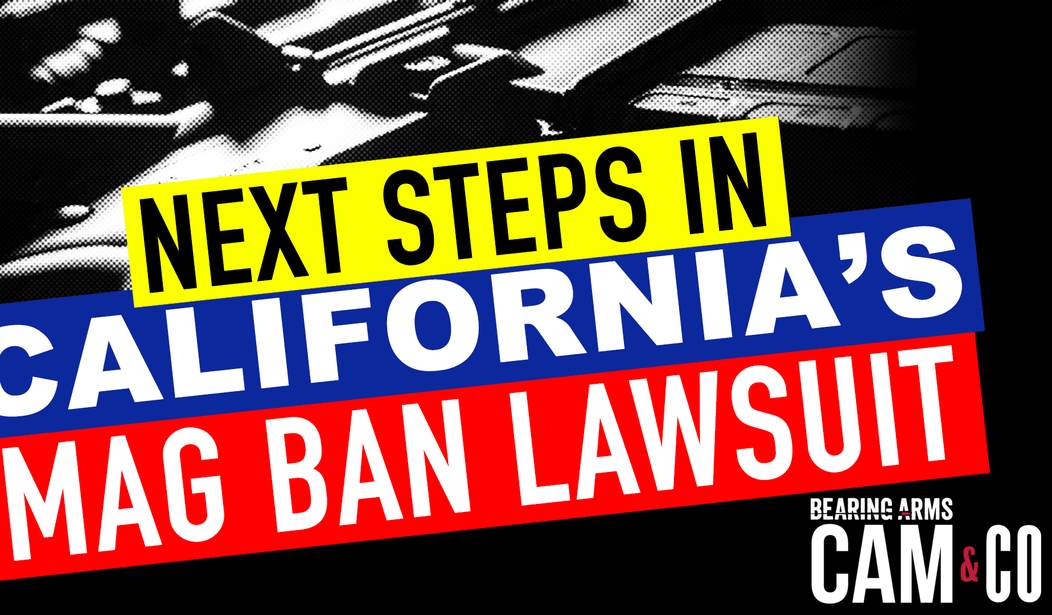On Tuesday, the Ninth Circuit Court of Appeals declared that California’s ban on “large capacity” magazines is fine and dandy, even though it does burden the right to keep and bear arms. But the law, which not only bans the sale of new ammunition magazines that can hold more than ten rounds but requires existing owners to get rid of any pre-ban magazines in their possession, remains at least partially on hold, at least for now.
California Rifle & Pistol Association head and Second Amendment attorney Chuck Michel joins Bearing Arms Cam & Co today to talk about the next steps for both California gun owners and 2A activists around the country when it comes to the Ninth Circuit’s opinion in Duncan v. Bonta, and it’s clear that this legal battle is far from over.
First, let’s get to the practical aspects of the court’s decision. Michel says that those who possess a pre-ban magazine (or those who purchased a magazine during the one week that the law was completely stayed by a federal judge) can keep them while the case is on appeal, at least until or if the Ninth Circuit lifts the stay on enforcing that portion of the law.
And the Ninth Circuit’s decision will be appealed, Michel assured me. In fact, the Supreme Court and the Ninth Circuit should be officially notified of the appeal before the end of the month. What happens after that, however, is anyone’s guess, though Michel says he doesn’t anticipate the Court simply turning away the petition as soon as it’s filed.
Instead, Michel says that SCOTUS could very well end up holding on to the case until it renders its verdict in New York State Rifle & Pistol Association v. Bruen, which probably won’t happen until next June. Then justices could either remand the California mag ban case back to the lower courts with instructions based on the Bruen decision, grant cert and hear the case themselves, or (in a worst case scenario) deny cert and allow the Ninth Circuit’s decision to remain in place.
One big reason for Michel’s optimism regarding the Supreme Court is the way in which the Ninth Circuit reached its decision. Like many other lower courts, the majority on the en banc panel concluded that California’s magazine ban should be subjected to “intermediate scrutiny”; a vague and fuzzy middle ground that allows onerous and burdensome restrictions on the right to keep and bear arms as long as the maker of those laws claim that they serve some sort of public safety benefit.
In the Duncan case the Ninth Circuit concluded that yes, California’s magazine ban does burden the right to keep and bear arms, but because California lawmakers “reasonably” believe that the law saves lives the infringement is okay. From the Ninth Circuit’s opinion:
The court assumed, without deciding, that California’s law implicates the Second Amendment, and joining its sister circuits that have unanimously applied intermediate scrutiny to other laws banning or restricting large-capacity magazines, determined that intermediate scrutiny applied because the ban imposed only a minimal burden on the core Second Amendment right to keep and bear arms.
Applying intermediate scrutiny, the court held that section 32310 was a reasonable fit for the important government interest of reducing gun violence. The statute outlaws no weapon, but only limits the size of the magazine that may be used with firearms, and the record demonstrates (a) that the limitation interferes only minimally with the core right of self-defense, as there is no evidence that anyone ever has been unable to defend his or her home and family due to the lack of a large-capacity magazine; and (b) that the limitation saves lives.
The court noted that in the past half-century, large-capacity magazines have been used in about three-quarters of gun massacres with 10 or more deaths and in 100 percent of gun massacres with 20 or more deaths, and more than twice as many people have been killed or injured in mass shootings that involved a large-capacity magazine as compared with mass shootings that involved a smaller-capacity magazine. Accordingly, the ban on legal possession of large-capacity magazines reasonably supported California’s effort to reduce the devastating damage wrought by mass shootings.
Now, under that standard the Supreme Court never should have tossed out Washington, D.C.’s ban on handguns back in 2008. After all, handguns are used in far more violent crimes than long guns (even those scary “assault weapons”), so why wouldn’t D.C.’s ban “reasonably support” the District’s effort to reduce the devastating damage brought by armed robberies, carjackings, and homicides committed by someone using a pistol?
Because, as Justice Antonin Scalia wrote in the Heller opinion, banning an entire class of arms that are in common use violates the Second Amendment no matter what level of scrutiny courts want to adopt. Even if handguns are the most commonly-used firearm in crimes, they’re also commonly owned for lawful purposes by tens of millions of Americans and cannot be banned outright.
Well, “large capacity” magazines are also very much in common use by law-abiding gun owners across the country. In fact, the National Shooting Sports Foundation estimates that there are 80-million magazines in the United States with a capacity of 30+ rounds, and the number of 10+ round magazines is obviously much greater.
Under any “reasonable” reading of the Heller decision the Ninth Circuit should have concluded that California’s magazine ban was unconstitutional. But since it chose to use intermediate scrutiny, Michel believes that will generate some interest among justices; particularly those like Brett Kavanaugh, who’s argued in the past that the proper standard of review should be the history, text, and tradition of the right to keep and bear arms.
The Supreme Court is expected to deal directly with the issue of the proper standard of review in Second Amenment cases when it issues its decision in Bruen, and Michel says there’s good reason to believe that the Court’s opinion will have a big impact not only on California’s magazine ban, but many of the other draconian restrictions on the right to keep and bear arms. The anti-gun, Democrat-appointed judges on the Ninth Circuit who comprised a majority of the en banc panel reviewing the Duncan case may have done their best to keep California’s magazine ban on the books, but hopefully they won’t have the last word on the law’s constitutionality.








Join the conversation as a VIP Member